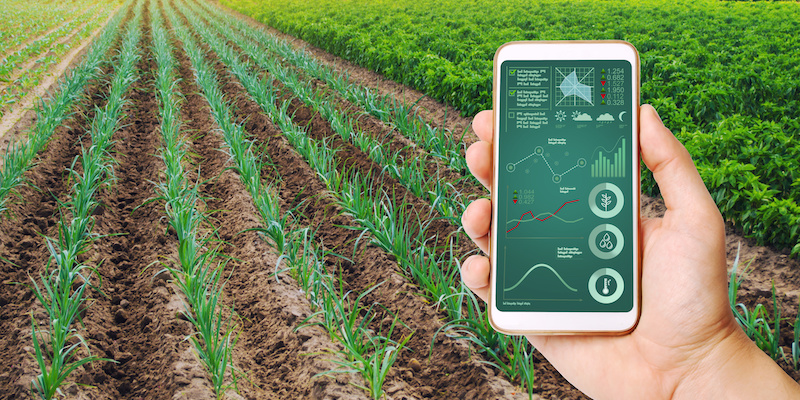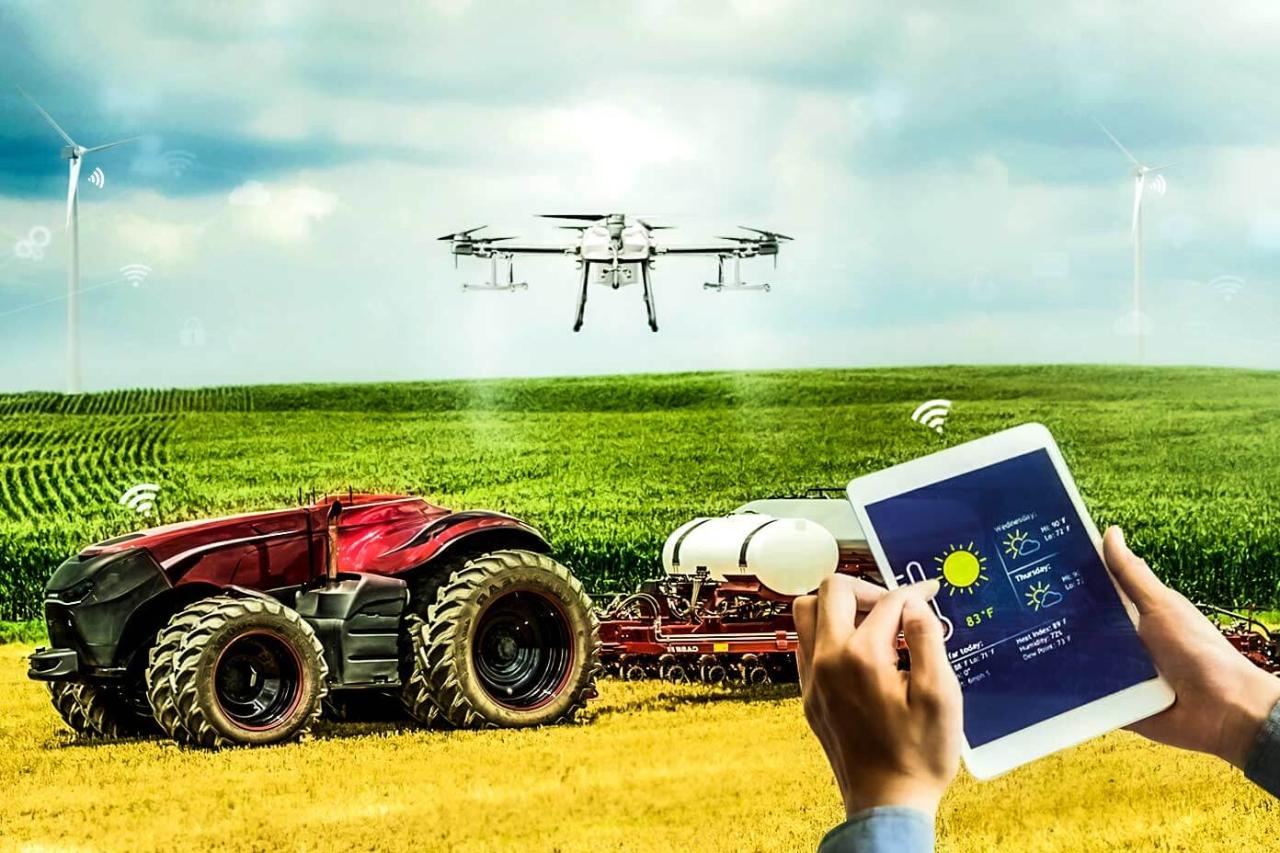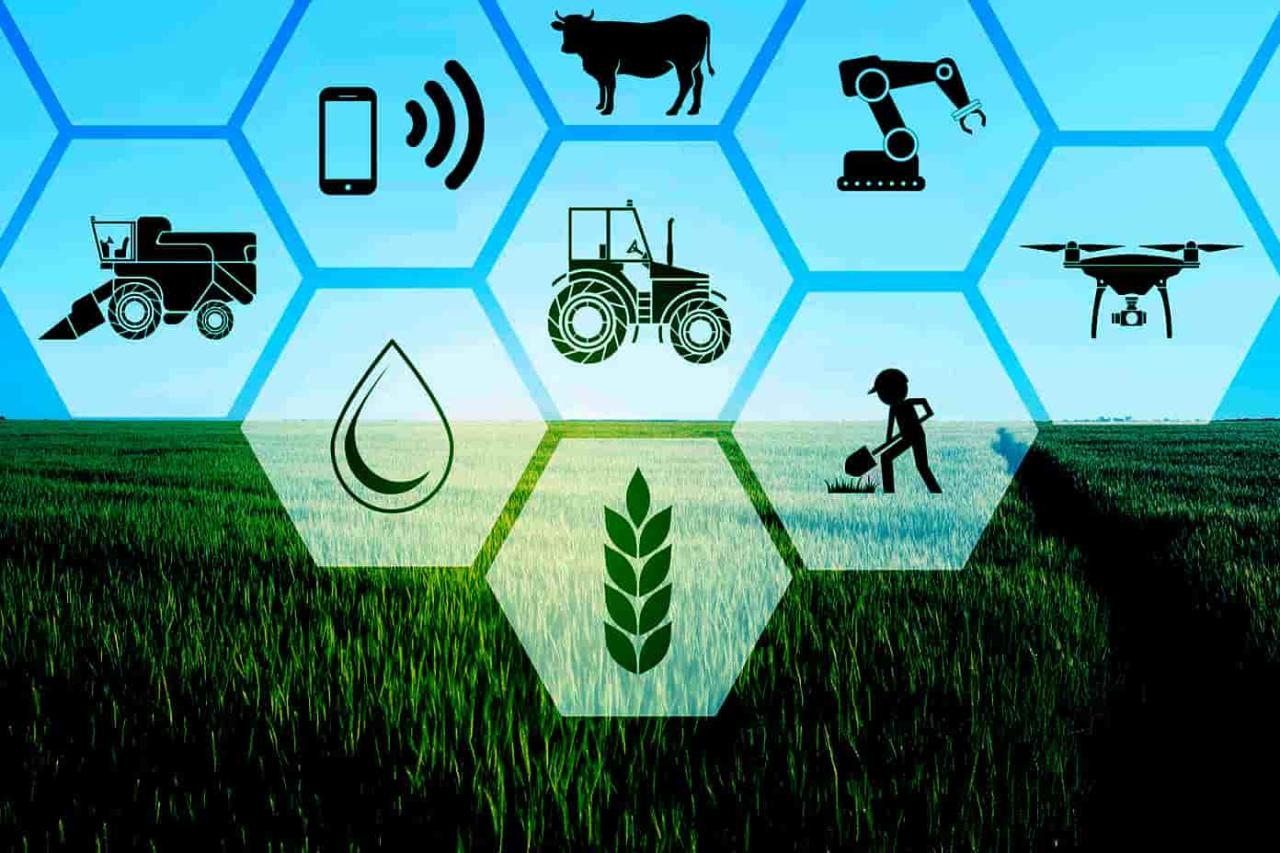Agribusiness Technology: Shaping the Future of Farming
Agribusiness technology is revolutionizing the way we grow and consume food. From precision farming to agricultural robotics, technology is transforming the agricultural industry, driving efficiency, sustainability, and innovation. This article […]

Agribusiness technology is revolutionizing the way we grow and consume food. From precision farming to agricultural robotics, technology is transforming the agricultural industry, driving efficiency, sustainability, and innovation.
This article explores the key areas of agribusiness technology, examining its impact on various aspects of agriculture, from crop production to food distribution. We’ll delve into the challenges and opportunities presented by these technologies, highlighting their potential to address global food security and environmental concerns.
Introduction to Agribusiness Technology
Agribusiness technology encompasses the application of technological advancements to various aspects of the agricultural industry, from farm management to food processing and distribution. This field aims to enhance efficiency, productivity, and sustainability in agricultural practices, contributing to a more robust and resilient food system.
Importance of Agribusiness Technology in Modern Agriculture
The importance of agribusiness technology in modern agriculture is undeniable. It plays a crucial role in addressing the growing global food demand, while simultaneously striving for sustainable practices.
- Increased Efficiency and Productivity: Agribusiness technology enables farmers to optimize resource utilization, minimize waste, and enhance yields. Precision farming techniques, for instance, allow farmers to apply inputs like fertilizers and pesticides only where needed, reducing costs and environmental impact.
- Improved Food Quality and Safety: Technology plays a vital role in ensuring food safety and quality. From traceability systems that track food products from farm to table to advanced sensors that monitor food storage conditions, agribusiness technology contributes to a safer and more reliable food supply chain.
- Sustainable Agricultural Practices: Agribusiness technology promotes sustainable agricultural practices by enabling farmers to conserve resources, reduce environmental pollution, and minimize the use of harmful chemicals. Examples include precision irrigation systems that optimize water usage and remote sensing technologies that monitor crop health and identify areas requiring intervention.
- Enhanced Market Access and Profitability: Agribusiness technology provides farmers with access to real-time market information, enabling them to make informed decisions about production and marketing. It also facilitates the development of new markets and value-added products, ultimately leading to increased profitability.
Key Areas of Agribusiness Technology
Agribusiness technology encompasses a wide range of innovations that are transforming the way we produce, process, and distribute food and agricultural products. These technologies are addressing critical challenges such as increasing food production to meet growing global demand, improving resource efficiency, and enhancing sustainability in agricultural practices.
Precision Agriculture
Precision agriculture utilizes technology to optimize farming practices based on specific conditions within a field. This approach involves collecting data on soil conditions, crop health, and weather patterns to make informed decisions about planting, fertilization, irrigation, and pest control.
- Sensors play a crucial role in collecting data about various aspects of the farm environment. Soil sensors measure moisture levels, nutrient content, and temperature, while crop sensors monitor plant growth, disease, and stress levels. Weather stations provide real-time data on rainfall, temperature, and wind speed.
- Drones are increasingly used in precision agriculture for aerial surveillance and data collection. They can capture high-resolution images and videos of crops, allowing farmers to monitor crop health, identify disease outbreaks, and assess the effectiveness of fertilizer applications. Drones equipped with sensors can also collect data on soil conditions, weed growth, and pest infestations.
- GPS technology enables precise navigation and mapping of fields. Farmers use GPS-guided tractors and sprayers to apply fertilizers, pesticides, and seeds with pinpoint accuracy, reducing waste and maximizing efficiency. GPS data can also be used to create detailed maps of fields, identifying areas with different soil types or crop yields.
Examples of precision agriculture technologies in action include:
- Variable-rate fertilization systems that adjust the amount of fertilizer applied based on soil nutrient levels.
- Precision irrigation systems that optimize water usage by applying water only to areas that need it.
- Smart pest control systems that use sensors to detect pest infestations and trigger targeted treatments.
Agricultural Robotics
Agricultural robots are designed to automate various tasks in farming, such as planting, harvesting, weeding, and spraying. They offer advantages in terms of efficiency, accuracy, and labor reduction.
- Planting robots can precisely place seeds at optimal depths and spacing, ensuring consistent germination and crop growth. They can also apply fertilizers and pesticides at the same time, further enhancing efficiency.
- Harvesting robots are capable of picking fruits, vegetables, and other crops with speed and accuracy, reducing the need for manual labor. They can also sort and grade produce, minimizing waste and improving quality.
- Weeding robots use various technologies, such as vision systems and sensors, to identify and remove weeds, reducing the reliance on herbicides and minimizing environmental impact.
Benefits of using agricultural robots include:
- Increased productivity and efficiency, as robots can work continuously and at a faster pace than humans.
- Improved accuracy and precision, leading to less waste and higher yields.
- Reduced labor costs and dependence on human workers.
- Enhanced safety for workers by automating hazardous tasks.
Challenges and limitations of agricultural robotics include:
- High initial investment costs for robotic equipment.
- Technical complexity and maintenance requirements.
- Limited adaptability to different crop types and field conditions.
- Concerns about job displacement for human workers.
Data Analytics and Big Data in Agriculture
Data analytics plays a crucial role in agribusiness by providing insights from large datasets, enabling better decision-making and optimizing agricultural practices.
Data analytics is used in various ways in agribusiness, including:
- Crop yield prediction: Analyzing historical data on weather patterns, soil conditions, and crop performance can help predict future yields and optimize planting decisions.
- Resource management: Data analytics can optimize resource allocation by analyzing data on water usage, fertilizer application, and pest control, leading to improved efficiency and reduced environmental impact.
- Market trend analysis: Analyzing market data on prices, demand, and supply can help agribusinesses make informed decisions about production, pricing, and marketing strategies.
Examples of data analytics applications in agriculture include:
- Precision farming software that uses sensor data to create detailed maps of fields, identifying areas with different soil conditions or crop yields.
- Yield monitoring systems that track crop growth and predict yields based on real-time data.
- Market intelligence platforms that analyze market data to identify trends and opportunities.
Challenges and Opportunities in Agribusiness Technology
The integration of technology in agriculture holds immense potential for enhancing productivity, efficiency, and sustainability. However, the adoption and implementation of these technologies present various challenges and opportunities that need to be carefully considered. This section explores key aspects related to the adoption, sustainability, and economic and social impacts of agribusiness technologies.
Adoption and Implementation
The adoption of new technologies in agriculture is influenced by several factors, including access to information, financial resources, infrastructure, and the perceived benefits of the technology.
- Challenges of Adopting New Technologies in Agriculture: Farmers often face challenges in adopting new technologies due to factors such as:
- Lack of awareness and knowledge: Farmers may not be aware of the latest technological advancements or how they can benefit their operations.
- Financial constraints: The initial investment in technology can be significant, posing a barrier for many farmers, especially those with limited resources.
- Lack of infrastructure: Access to reliable internet connectivity, electricity, and other essential infrastructure is crucial for the successful implementation of many technologies.
- Complexity of technology: Some technologies may be complex to operate and require specialized training, which can be a deterrent for farmers.
- Lack of trust: Farmers may be hesitant to adopt new technologies due to concerns about their reliability, effectiveness, or potential risks.
- Factors Influencing Technology Adoption by Farmers: Several factors influence farmers’ decisions to adopt new technologies, including:
- Economic benefits: Farmers are more likely to adopt technologies that offer clear economic advantages, such as increased yields, reduced input costs, or improved efficiency.
- Social networks: Recommendations from trusted sources, such as other farmers, agricultural extension services, or industry experts, can significantly influence technology adoption.
- Government policies: Government policies, such as subsidies, tax incentives, or educational programs, can play a role in encouraging technology adoption.
- Access to information: Farmers need access to reliable information about new technologies, their benefits, and how to implement them effectively.
- Risk aversion: Farmers are often risk-averse and may be hesitant to adopt technologies that they perceive as risky or uncertain.
- Strategies for Promoting Technology Adoption in Agribusiness: Several strategies can be employed to promote technology adoption in agribusiness, including:
- Education and training: Providing farmers with training and educational resources on new technologies can help them understand their benefits and overcome technical barriers.
- Demonstration farms: Establishing demonstration farms where farmers can see the benefits of new technologies firsthand can be effective in promoting adoption.
- Financial incentives: Government subsidies, grants, or loan programs can help farmers offset the initial investment costs of new technologies.
- Public-private partnerships: Collaboration between government agencies, research institutions, and private companies can facilitate the development and dissemination of new technologies.
- Access to financing: Making financing options available to farmers, such as microloans or crop insurance, can help them acquire the resources needed to invest in technology.
Future Trends in Agribusiness Technology

The agricultural industry is undergoing a significant transformation, driven by technological advancements that are revolutionizing how food is produced, processed, and distributed. These advancements are paving the way for a more efficient, sustainable, and resilient food system. This section explores some of the key future trends in agribusiness technology.
Artificial Intelligence (AI) and Machine Learning, Agribusiness technology
AI and machine learning are rapidly transforming the agricultural landscape. These technologies are being used to analyze vast amounts of data from sensors, drones, and satellite imagery to optimize crop yields, manage pests, and predict weather patterns.
- Optimizing Crop Yields: AI algorithms can analyze data from various sources, such as soil moisture sensors, weather stations, and satellite imagery, to identify patterns and predict optimal planting dates, irrigation schedules, and fertilization needs. This allows farmers to make informed decisions that maximize crop yields and minimize resource waste. For example, AI-powered systems can analyze historical weather data and soil conditions to predict the best time to plant specific crops, increasing the chances of successful harvests.
- Managing Pests: AI can be used to develop intelligent pest management systems that monitor crop health and identify potential pest infestations early on. AI-powered drones and robots can be used to apply targeted pesticide treatments, reducing the need for broad-spectrum applications and minimizing environmental impact. For example, AI-powered drones can be equipped with cameras and sensors to detect pests and diseases in crops, allowing farmers to take immediate action to prevent widespread damage.
- Predicting Weather Patterns: AI algorithms can analyze historical weather data and current weather conditions to predict future weather patterns, including rainfall, temperature, and wind speed. This information can help farmers prepare for potential weather events, such as droughts or floods, and make informed decisions about planting, harvesting, and irrigation. For example, AI-powered weather forecasting systems can provide farmers with real-time information on rainfall patterns, enabling them to adjust irrigation schedules and prevent crop damage due to excessive watering or drought.
Despite the immense potential of AI in agriculture, there are also challenges and ethical considerations that need to be addressed. One concern is the potential for job displacement as AI-powered systems automate tasks currently performed by humans. Another ethical concern is the potential for bias in AI algorithms, which could lead to unfair or discriminatory outcomes. For example, AI-powered systems could be biased towards certain types of crops or farming practices, leading to inequitable outcomes for farmers and consumers. It is essential to develop and implement AI systems in a responsible and ethical manner to ensure that they benefit all stakeholders.
Agribusiness technology is constantly evolving, finding new ways to optimize efficiency and sustainability. A key area of focus is climate control, and the development of smart solutions like the climate technology thermostat is helping farmers precisely manage their environments.
By integrating these advancements, agribusiness can not only improve crop yields but also contribute to a more sustainable future.
Blockchain Technology
Blockchain technology is a distributed ledger system that can be used to track and verify transactions across a network of computers. In agriculture, blockchain can be used to track food supply chains, ensuring food safety and supporting fair trade practices.
- Tracking Food Supply Chains: Blockchain can be used to create a transparent and immutable record of the origin, processing, and distribution of food products. This allows consumers to trace the journey of their food from farm to table, providing them with greater confidence in its safety and quality. For example, a blockchain-based system can track the movement of produce from a farm to a packing facility, a distribution center, and ultimately to a supermarket, ensuring that each step is documented and verifiable.
- Ensuring Food Safety: Blockchain can help to prevent food fraud and ensure food safety by providing a tamper-proof record of food products. This can help to identify and track contaminated products quickly, preventing outbreaks of foodborne illnesses. For example, blockchain can be used to track the use of pesticides and other chemicals in food production, ensuring that products meet safety standards and regulations.
- Supporting Fair Trade Practices: Blockchain can be used to create a transparent and equitable system for trading agricultural products. This can help to ensure that farmers receive fair prices for their produce and that consumers can purchase products from ethical and sustainable sources. For example, blockchain can be used to track the origin of coffee beans, ensuring that farmers in developing countries receive a fair price for their products and that consumers can purchase coffee that is ethically sourced.
The adoption of blockchain technology in agribusiness is still in its early stages, and there are challenges to overcome. One challenge is the need for interoperability between different blockchain platforms. Another challenge is the need for education and awareness among stakeholders about the benefits of blockchain technology. Despite these challenges, the potential of blockchain to transform the agricultural industry is significant. As the technology matures and adoption increases, it is expected to play a key role in creating a more efficient, transparent, and sustainable food system.
Nanotechnology and Sensor Networks
Nanotechnology and sensor networks are playing an increasingly important role in agriculture. These technologies can be used for precision monitoring, disease detection, and enhanced nutrient delivery.
- Precision Monitoring: Nanotechnology-based sensors can be used to monitor crop health and soil conditions in real-time. These sensors can provide data on factors such as soil moisture, nutrient levels, and pest infestations, allowing farmers to make informed decisions about irrigation, fertilization, and pest management. For example, nanotechnology-based sensors can be embedded in soil to monitor moisture levels and alert farmers when irrigation is needed, preventing overwatering and maximizing water efficiency.
- Disease Detection: Nanotechnology can be used to develop highly sensitive sensors that can detect diseases in crops at an early stage. This allows farmers to take immediate action to prevent the spread of disease and minimize crop losses. For example, nanotechnology-based sensors can be used to detect the presence of pathogens in crops, allowing farmers to treat affected plants and prevent the disease from spreading to healthy plants.
- Enhanced Nutrient Delivery: Nanotechnology can be used to develop targeted nutrient delivery systems that release nutrients directly to plants, improving nutrient uptake and reducing fertilizer waste. This can help to improve crop yields and reduce the environmental impact of agriculture. For example, nanotechnology-based fertilizers can be formulated to release nutrients slowly over time, ensuring that plants receive the nutrients they need when they need them, minimizing nutrient loss and environmental pollution.
Nanotechnology in agriculture also raises ethical considerations, such as the potential for unintended environmental impacts and the need for careful regulation to ensure safe and responsible use. It is essential to conduct thorough research and develop clear guidelines to mitigate potential risks and maximize the benefits of nanotechnology in agriculture.
Case Studies and Examples of Agribusiness Technology

Agribusiness technology is not just a theoretical concept; it’s being implemented in real-world scenarios, transforming the way we produce, process, and distribute food. To better understand the impact of these technologies, let’s delve into some specific examples and their applications.
Case Studies and Examples of Agribusiness Technology
The following table showcases various agribusiness technologies, their applications, benefits, and associated challenges.
| Technology | Application | Benefits | Challenges |
|---|---|---|---|
| Precision Farming with GPS and Yield Mapping | Optimizing fertilizer and pesticide application based on real-time soil and crop data. | Increased crop yields, reduced input costs, and minimized environmental impact. | High initial investment costs, need for skilled personnel, and potential for data privacy concerns. |
| Agricultural Robots for Harvesting | Automating fruit and vegetable harvesting tasks, reducing labor costs and improving efficiency. | Increased productivity, reduced labor costs, and improved product quality. | High initial investment costs, limited adaptability to diverse crop types, and potential for job displacement. |
| Data Analytics for Crop Disease Prediction | Analyzing data from sensors, drones, and weather stations to predict and prevent crop diseases. | Early disease detection, targeted interventions, and reduced crop losses. | Need for large datasets, data security concerns, and potential for over-reliance on technology. |
| Vertical Farming for Urban Agriculture | Growing crops in stacked layers in controlled environments, maximizing land use and reducing transportation costs. | Increased food production in urban areas, year-round harvests, and reduced environmental impact. | High energy consumption, limited scalability, and potential for high operating costs. |
| Blockchain Technology for Supply Chain Transparency | Tracking food products from farm to table, ensuring traceability and enhancing food safety. | Increased consumer confidence, reduced fraud, and improved supply chain efficiency. | Complexity of implementation, need for industry-wide adoption, and potential for data security breaches. |
Conclusion

The integration of technology into the agricultural sector is revolutionizing the way we produce, manage, and distribute food. From precision farming and data analytics to robotics and artificial intelligence, agribusiness technology is driving efficiency, sustainability, and profitability in the food system.
The Importance of Agribusiness Technology for the Future of Agriculture
Agribusiness technology is essential for meeting the growing global demand for food while addressing the challenges of climate change, resource scarcity, and population growth.
- By optimizing resource use and reducing waste, agribusiness technology can help ensure food security and protect the environment.
- Data-driven decision-making empowers farmers to make informed choices, improving yields and profitability.
- Innovations in agricultural technology can create new markets and opportunities for farmers and businesses.
Closure
As agribusiness technology continues to advance, it promises to reshape the future of agriculture, creating a more efficient, sustainable, and resilient food system. By embracing these innovations, we can ensure a future where food production meets the needs of a growing population while safeguarding the planet for generations to come.



